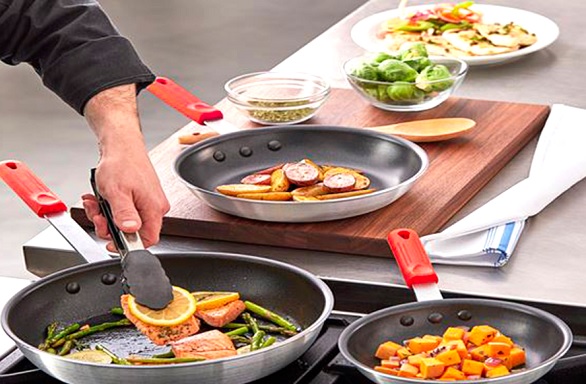Is my nonstick cookware safe?
As if making healthy food choices was not hard enough, it has now become necessary to also pay attention to the pans we cook in due to the potential health implications associated with them.
Nonstick cookware has become a popular choice for many households due to its convenience and ease of use.
Nonstick coatings are found in products ranging from cooking pans, sandwich makers, waffle makers and air fryers.
The coating makes it easier to turn pancakes, sausages and fried eggs.
It is useful for cooking delicate foods that might otherwise stick to the pan.
It is also easier to clean and wash, making it a preferable cooking utensil of choice for most homes.
However, recent studies have raised concerns about the potential dangers of nonstick cookware, especially substandard ones.
The article examines the potential health risks associated with non-stick cookware and explores safer alternatives.
Concerns
Nonstick cookware is coated with a synthetic chemical called polytetrafluoroethylene (PTFE), commonly known as Teflon.
Up until 2013, Teflon contained a chemical called perfluorooctanoic acid (PFOA).
Since then, all Teflon products are PFOA-free, even though they still have other substances known as PFAS (per- and polyfluoroalkyl), that are not fully understood.
When heated to high temperatures [over 260C (536F)], this coating can release toxic fumes that can be harmful to human health.
These temperatures could be lower for low-standard Teflon-coated cookware, which could pose more danger.
These fumes can cause a condition known as poly fume fever, which can cause flu-like symptoms such as fever, chills and coughing.
Prolonged exposure to these fumes is linked to more serious health problems, such as respiratory issues and cancer.
Ingestion is also associated with an increased risk of pre-eclampsia in pregnant women, a decrease in infant birth weights and liver injuries.
In addition to the potential health risk, there are also environmental concerns.
The chemicals used for the non-stick coating are not biodegradable and can persist in the environment for many years.
These chemicals can contaminate water sources and harm wildlife.
Safer alternatives
To reduce the risk associated with nonstick cookware, it is recommended to use cookware made from safer materials, such as stainless steel, titanium, glass, ceramic and local Ghanaian earthenware utensils such as Asanka.
These materials are durable, long-lasting and do not release toxic fumes when heated.
Stainless steel and earthenware utensils are also great for cooking at high temperatures, making them ideal for searing meat and achieving a crispy crust on vegetables.
Ceramics and earthen cookware are safer non-toxic alternatives to non-stick cookware, as they are scratch resistant, easy to clean and do not contain any harmful chemicals.
However, the earthenware pots need to be dried properly after use to avoid mould and fungal growth, which may be unsafe.
It is also important to note that all these safer alternatives should be used according to the manufacturer’s direction and should also be of good quality.
Tips
If you must use nonstick cookware, it is important to use it at low to medium temperatures and to avoid overheating.
Do not preheat before use.
Overheating nonstick cookware can cause the coating to break down releasing toxic fumes into the air.
It is also important to avoid using metal utensils on non-stick cookware, as this can scratch the coating and cause it to break down more quickly.
Not cleaning nonstick cookware the correct way can also be a potential hazard.
Avoid using abrasive cleaners, such as steel wool or scouring pads, as these can scratch the coating and cause it to break down more quickly.
Instead, use a soft sponge or cloth and mild dish soap to clean nonstick cookware.
You should also replace old Teflon coatings cookware when they start to deteriorate with excessive scratches, peeling, flaking, and chipping. Replace it immediately.
Finally, when cooking with nonstick cookware, open windows to help clear any fumes that may come out of the pan.
Conclusion
In conclusion, while nonstick cookware can be convenient, it is important to be aware of the potential risks associated with its use.
While there is still ongoing research to further understand how they impact the human body, it is important to either handle them safely or choose other safer alternatives to protect your health and environment.
Safer alternatives, such as stainless steel, local earthenware, and ceramic cookware are also durable and long-lasting and do not release any toxic fumes when heated.
If you must use nonstick cookware, be sure to use it at low to medium temperatures to avoid overheating it.
Use gentle cleaning methods.
It is also very important to purchase high-quality Teflon-coated cookware since the low-grade ones can more easily expose you to health hazards.
By being mindful of the potential dangers of non-stick cookware and taking steps to reduce exposure, we can create a safer and healthier kitchen environment.
The writers are with the Department of Dietetics,
College of Health Sciences,
University of Ghana.
E-mails: priscillaafrah12@gmail.com & feahayford@ug.edu.gh or feahayford220580@gmail.com



